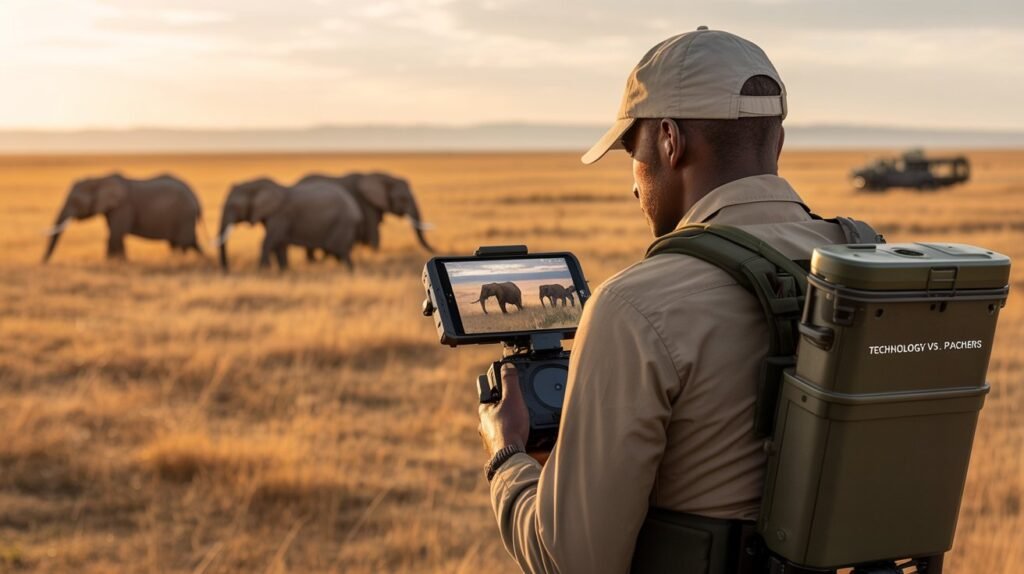Africa’s wildlife reserves stretch across millions of acres of open savannah, dense forests, and rugged mountains. Protecting such vast landscapes from organised poaching networks has always been an immense challenge. With limited manpower and difficult terrain, rangers have long struggled to stay one step ahead of those who kill for profit. But today, a quiet revolution is underway — one powered not by boots on the ground, but by technology and innovation.
The Rise of Smart Conservation
The fight to save Africa’s wildlife is no longer waged with rifles and radios alone. From thermal imaging drones that detect movement at night to AI-driven animal tracking systems that follow herds across borders, technology is reshaping what’s possible in conservation. These tools offer eyes in the sky, ears in the forest, and real-time data that can mean the difference between life and death for endangered species.
In Kenya, for example, drones equipped with infrared cameras patrol vast areas that would take days for rangers to cover on foot. They can spot a moving target — human or animal — even through thick vegetation or in total darkness. In South Africa’s Kruger National Park, acoustic sensors pick up gunshots or vehicle sounds miles away, triggering instant alerts to nearby patrols. Each innovation narrows the poachers’ window of opportunity.
Data That Predicts Danger
Beyond surveillance, data analysis is becoming one of conservation’s most powerful weapons. Using artificial intelligence and machine learning, analysts can now predict poaching hotspots before attacks happen. Algorithms study years of data — including weather patterns, migration routes, and past incidents — to forecast where poachers are most likely to strike.
This proactive approach allows anti-poaching units to focus their limited resources where they’re needed most. Instead of reacting to threats, they can anticipate them. It’s a shift from defence to prevention — one made possible by advanced analytics and continuous data collection across protected areas.
Partnerships Powering Change
None of this progress happens in isolation. Across the continent, tech companies and conservation organisations are forming partnerships that merge technical expertise with field experience. Giants like Microsoft and Google have supported projects using AI wildlife protection systems capable of identifying species, detecting human movement, and flagging potential poaching risks in real time. Start-ups and NGOs are working together to develop cost-effective anti-poaching technology that can be deployed even in remote areas with limited connectivity.
For instance, the non-profit Wildlife Protection Solutions uses cloud-based platforms to connect thousands of remote camera traps, providing park managers with immediate alerts when poachers are detected. Meanwhile, conservation tech hubs in Nairobi and Cape Town are incubating home-grown innovations — from solar-powered sensors to mobile ranger apps that map patrol routes and record field data.
Looking Ahead: The Future of Smart Protection
The next frontier lies in combining these technologies into a single, intelligent ecosystem. As satellite AI and machine learning continue to advance, conservationists envision a future where poaching is not just prevented — it’s predicted and eliminated. High-resolution satellite imagery could soon detect suspicious activity across entire regions, while automated drones respond instantly without human command.
These tools will allow rangers to act faster, safer, and smarter, ensuring that Africa’s most iconic species — elephants, rhinos, lions — can thrive once more. With continued investment and collaboration, innovation may yet tip the balance in this long and difficult fight.
Protecting the Future
In the struggle between poachers and protectors, technology is proving to be the decisive force. By harnessing AI, sensors, and smart data, technology anti-poaching Africa efforts are turning the tide. Every algorithm, every drone flight, every partnership brings the continent closer to a future where conservation no longer plays catch-up — it leads the way.
Want more to read? Visit dDooks.


